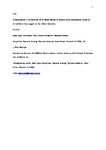A Computational Fluid Dynamics (CFD) Based Method for Assessing the Hydrodynamic Impact of Animal Borne Data Loggers on Host Marine Mammals
| dc.contributor.author | Kyte, Adam | |
| dc.contributor.author | Pass, C | |
| dc.contributor.author | Pemberton, Richard | |
| dc.contributor.author | Sharman, M | |
| dc.contributor.author | McKnight, JC | |
| dc.contributor.editor | Boness DJ | |
| dc.date.accessioned | 2018-08-16T13:54:41Z | |
| dc.date.issued | 2019-04 | |
| dc.identifier.issn | 0824-0469 | |
| dc.identifier.issn | 1748-7692 | |
| dc.identifier.uri | http://hdl.handle.net/10026.1/12161 | |
| dc.description | Full text embargoed until 31.10.2019 (publisher's embargo period, 12 months) | |
| dc.description.abstract |
Animal-borne data loggers (ABDLs) or “tags” are regularly used to elucidate animal ecology and physiology, but current literature highlights the need to assess associated deleterious impacts including increased resistive force to motion. Previous studies have used Computational Fluid Dynamics (CFD) to estimate this impact, but many suffer limitations (e.g., inaccurate turbulence modeling, neglecting boundary layer transition, neglecting added mass effects, and analyzing the ABDL in isolation from the animal). A novel CFD-based method is presented in which a “tag impact envelope” is defined utilizing simulations with and without transition modelling to define upper and lower drag limits, respectively, and added mass coefficients are found via simulations with sinusoidally varying inlet velocity, with modified Navier-Stokes conservation of momentum equations enforcing a shift to the animal’s noninertial reference frame. The method generates coefficients for calculating total resistive force for any velocity and acceleration combination, and is validated against theory for a prolate spheroid. An example case shows ABDL drag impact on a harp seal of 11.21% - 16.24%, with negligible influence on added mass. By considering the effects of added mass and boundary layer transition, the approach presented is an enhancement to the CFD-based ABDL impact assessment methods previously applied by researchers. | |
| dc.format.extent | 364-394 | |
| dc.language | en | |
| dc.language.iso | en | |
| dc.publisher | Wiley | |
| dc.subject | ABDL | |
| dc.subject | Animal-Borne Data Loggers | |
| dc.subject | Added Mass | |
| dc.subject | Bio-logging | |
| dc.subject | Boundary Layer Transition | |
| dc.subject | CFD | |
| dc.subject | Computational Fluid Dynamics | |
| dc.subject | Hydrodynamics | |
| dc.subject | Tag | |
| dc.subject | Telemetry | |
| dc.title | A Computational Fluid Dynamics (CFD) Based Method for Assessing the Hydrodynamic Impact of Animal Borne Data Loggers on Host Marine Mammals | |
| dc.type | journal-article | |
| dc.type | Journal Article | |
| plymouth.author-url | https://www.webofscience.com/api/gateway?GWVersion=2&SrcApp=PARTNER_APP&SrcAuth=LinksAMR&KeyUT=WOS:000468040700001&DestLinkType=FullRecord&DestApp=ALL_WOS&UsrCustomerID=11bb513d99f797142bcfeffcc58ea008 | |
| plymouth.issue | 2 | |
| plymouth.volume | 35 | |
| plymouth.publication-status | Published | |
| plymouth.journal | Marine Mammal Science | |
| dc.identifier.doi | 10.1111/mms.12540 | |
| plymouth.organisational-group | /Plymouth | |
| plymouth.organisational-group | /Plymouth/Faculty of Science and Engineering | |
| plymouth.organisational-group | /Plymouth/Faculty of Science and Engineering/School of Engineering, Computing and Mathematics | |
| plymouth.organisational-group | /Plymouth/REF 2021 Researchers by UoA | |
| plymouth.organisational-group | /Plymouth/REF 2021 Researchers by UoA/UoA12 Engineering | |
| plymouth.organisational-group | /Plymouth/Users by role | |
| plymouth.organisational-group | /Plymouth/Users by role/Academics | |
| plymouth.organisational-group | /Plymouth/Users by role/Researchers in ResearchFish submission | |
| dcterms.dateAccepted | 2018-06-12 | |
| dc.rights.embargodate | 2019-10-31 | |
| dc.identifier.eissn | 1748-7692 | |
| dc.rights.embargoperiod | Not known | |
| rioxxterms.versionofrecord | 10.1111/mms.12540 | |
| rioxxterms.licenseref.uri | http://www.rioxx.net/licenses/all-rights-reserved | |
| rioxxterms.type | Journal Article/Review |


